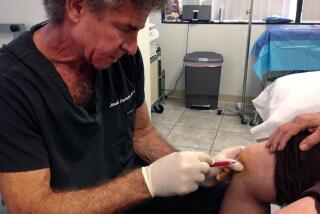Is California’s stem cell program preparing to waste $700,000?

If you’re betting that the California stem cell agency will spurn key recommendations of a blue-ribbon review panel that criticized its leadership and management structures, you might want to double that bet. Several board members showed overt hostility to the panel’s recommendations during a public meeting today.
The governing board of the agency, the California Institute for Regenerative Medicine, formally received the review report at its meeting today in Los Angeles. The Institute of Medicine, an affiliate of the National Academy of Sciences, was paid $700,000 by CIRM to conduct the yearlong study of the $6-billion state stem cell program.
The Institute of Medicine’s reviewers found that the structure of the governing board poses troubling conflicts of interest. Proposition 71, which established the program, designates almost all board seats for officials of institutions or companies eligible to receive CIRM grants or patient advocates for diseases thought to be targets for stem-cell therapies.
One result: Some 90% of all grants issued by CIRM have gone to institutions with representatives on the board.
The study panel said the board should be restructured to include a majority of independent members with no connections to grant-receiving institutions. The panel also advised the board to take itself out of the process of approving or disapproving individual grant and loan applications, and to cease accepting appeals from rejected applicants.
The review panel’s chairman, Harold Shapiro of Princeton University, observed, “The kind of conflicts that exist right now are very direct and very major, and they have to be handled in some way... It would be very healthy for the organization to just have more independent members.”
This recommendation closely tracks proposals aired in the past by other bodies that have examined CIRM’s insular decision-making, including the state’s Little Hoover Commission. CIRM consistently has rejected those that involve changing the board’s makeup.
CIRM Chairman Jonathan Thomas glided over those issues when he introduced Shapiro. Thomas observed that the Institute of Medicine report included many statements “validating CIRM, it’s process, what it was able to achieve,” which is a bit like launching the investigation of a plane crash by focusing on all the planes that land safely every day. Thomas did mention that the Institute of Medicine had made numerous recommendation about how to “take something which is already a great experience and improve it even further.”
Shapiro got only a few minutes into his presentation before board members started interrupting him with objections to the Institute of Medicine’s recommendation for a majority of independent members.
“I don’t believe the [report’s] conclusions on conflicts of interest or bias could be more incorrect,” complained board member Jonathan Shestack, a movie producer named to the board as an autism patient advocate. “There isn’t a whiff of bias, actually.”
Thomas promised to stage a public workshop on the Institute of Medicine report soon and to subject them to “lengthy discussion.”
Does that sound as if the board will be taking seriously the advice that it change the way it does business? Stay tuned, but don’t hold your breath.
Related:
Will CIRM take new criticisms to heart?
Did the stem cell program promise miracle cures?
More to Read
Inside the business of entertainment
The Wide Shot brings you news, analysis and insights on everything from streaming wars to production — and what it all means for the future.
You may occasionally receive promotional content from the Los Angeles Times.











